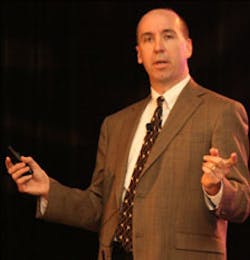So said global futurist and best-selling author Jack Uldrich during his keynote address at the Invensys Software Conference. Uldrich is the author of The Next Big Thing is Really Small and Jump the Curve: 50 Essential Strategies to Help your Company Stay Ahead of Emerging Technology.
Uldrich described 10 technological forces that are doubling every three to six months. These technologies range from wearable computers and 3D manufacturing to mobility and sensors. He reminded the audience that when something doubles 10 times, that’s a 1,000x increase. So, in 30 to 60 months (two to five years), all these big ideas that seem too expensive, too complicated or just plain impossible today are likely to be changing our worlds even more dramatically than they already have in just a short time.
Mobility technology and app development are two cases in point: “Today, over a million apps exist and more than a half million people are employed in this industry that did not even exist six years ago,” said Uldrich.
Despite the growing changes that technology is already bringing and will continue bring to our everyday lives, Uldrich said, “We’re still going to do the same things we’ve always done, but how we do them is going to change in some curious ways. We have to be open to these curiosities.”
An example of such a curiosity can be found in a new technology that could soon replace the $30,000 electrocardiogram machines in hospitals now. A doctor has developed a $199 smartphone case and app that can produce an electrocardiogram on the spot. That doctor also foresees using nano-scale sensors in our blood stream that would detect changes to cells that are a known precursor to a heart attack. Those nano sensors could detect the changes and transmit a special ringtone to your smartphone that warns you that you’re going to have a heart attack. How’s that for predictive maintenance?
The challenge for business, Uldrich says is to better perceive how new technology is becoming exponentially more powerful. To do that, we have to clear away a lot of old perceptions. As an example of all the old information stuck in all our heads, Uldrich asked the audience to turn to his/her neighbor and tell them the color of a yield sign. Most people said, “yellow and black.”
Despite that being the initial recollection of a yield sign for most, the fact is that yield signs are red and white, and have been since 1971. “So the next time you see a red and white yield sign—which will be the next time you drive your car—no matter what you’re thinking right now—I want you to think, ‘How is my world changing and I’m just not seeing it?’
“Not everything we think we know is necessarily true,” he added.
See Jack Uldrich speak in this YouTube video below.
About the Author
Renee Bassett
Managing Editor

Leaders relevant to this article:
